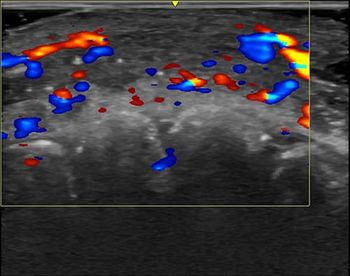
Prosty the Spokesgland (was a happy jolly soul)
Well, that might be an exaggeration. Prosty is not very jolly. Nor is he very happy. Actually, Prosty is downright mad. He wants to know -- and rightly so: Where is his Manogram?
Well, that might be an exaggeration. Prosty is not very jolly. Nor is he very happy. Actually, Prosty is downright mad. He wants to know - and rightly so: Where is his Manogram?
For as long as modern man can remember, prostate exams have been done digitally. Prosty would have them done with digital imaging.
This animated champion of men's rights, born of medical science and Madison Avenue, is waiting in the wings, ready to enter the limelight of public service. He is... (drum roll please) Prosty the Spokesgland! And his mission is nothing less than to change the practice of medicine.
In a public service announcement written to air on television, the animated gland balks after a few pokes from a friendly proctologist:
"I'm a sensitive prostate. Is this the Dark Ages? The '90s? You're going to miss a cancer....You need digital imaging to get the whole picture!"
This guy has attitude. His palooka-like body, menacing eyes, and clenched teeth make for the kind of gland you don't want to tick off. Visibly annoyed at a doctor's conventional digital exam, Prosty snipes: "Once more and we're dating."
If Prosty gets a chance, he is going to stir things up. And that's not a bad thing.
Prostate cancer strikes one in six men, according to Dr. Faina Shtern, director of research at the radiology department of Children's Hospital Boston.
"It's more common than breast cancer in women," said Shtern, president and CEO of the nonprofit AdMeTech Foundation, which created the public awareness campaign in which Prosty stars. "Yet, while women today have access to lifesaving mammograms, men lack accurate, accessible, and affordable diagnostic tools. It's time men had their own 'manogram' to save lives and quality of lives."
I couldn't agree more. Women talk openly of the need to have regular mammograms. Billboards, television spots, and magazine ads provide daily reminders. The most attention prostate exams get is an awkward moment and a glove snap on a late night rerun of Becker.
Prostate cancer is second only to lung cancer in occurrence among men in the U.S., yet it is locked in the backwaters of medical practice. PSA blood tests are the mainstay of modern screening, but some 15% of men with normal PSA levels still have prostate cancer. When PSA levels are abnormal, biopsies are negative in most men.
"Advanced imaging technologies will transform prostate cancer detection, biopsy, and treatment," Shtern said.
The "manogram" concept evolved from a partnership among AdMeTech and Hollywood producer Stephen Nemeth, Madison Avenue veteran Larry Kopald, and physician and TV journalist Dr. Bruce Hensel. Nemeth helped bring the manogram concept to life with Prosty the Spokesgland.
The public awareness campaign officially began Oct. 27, when advocates visited Capitol Hill to speak with lawmakers about the need to develop advanced imaging technologies to detect prostate cancer. Among the protagonists were executives from GE Healthcare and Siemens Medical Solutions.
Prosty, who has been poked and prodded by unnecessary biopsies, was the most outspoken. He has - dare I say it - "mass" appeal, and he's not afraid to use it. The creators of Prosty have written lyrics for him, sung to the obvious tune. The chorus is especially touching:
Lumpety lump lump, Lumpety lump lump, Look at Prosty grow
Lumpety lump lump, Lumpety lump lump, No more bending over so
(For all the lyrics, go to http://www.manogram.org.)
Prosty will get attention, assuming, of course, that the ad campaign goes as planned. There may be television stations that refuse to air this bratty little gland. Some print publications might even be skittish. I hope Prosty and his creators persist.
For the good of men everywhere, I have just one thing to say: You go, guy!
Newsletter
Stay at the forefront of radiology with the Diagnostic Imaging newsletter, delivering the latest news, clinical insights, and imaging advancements for today’s radiologists.




























